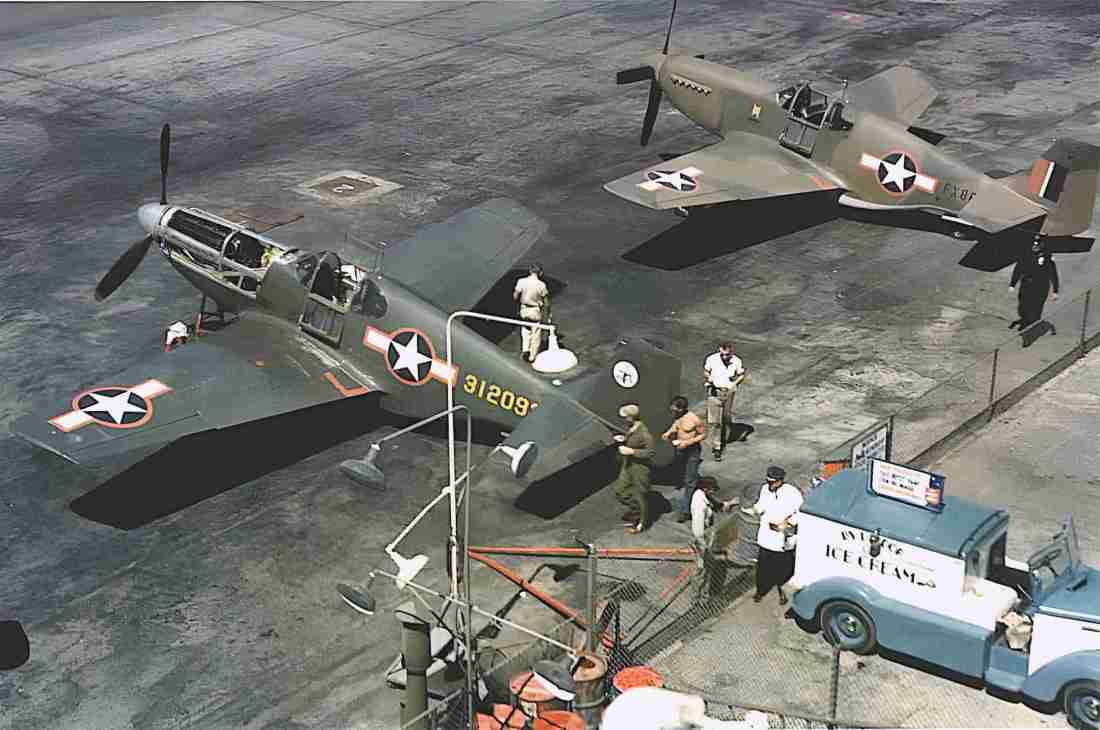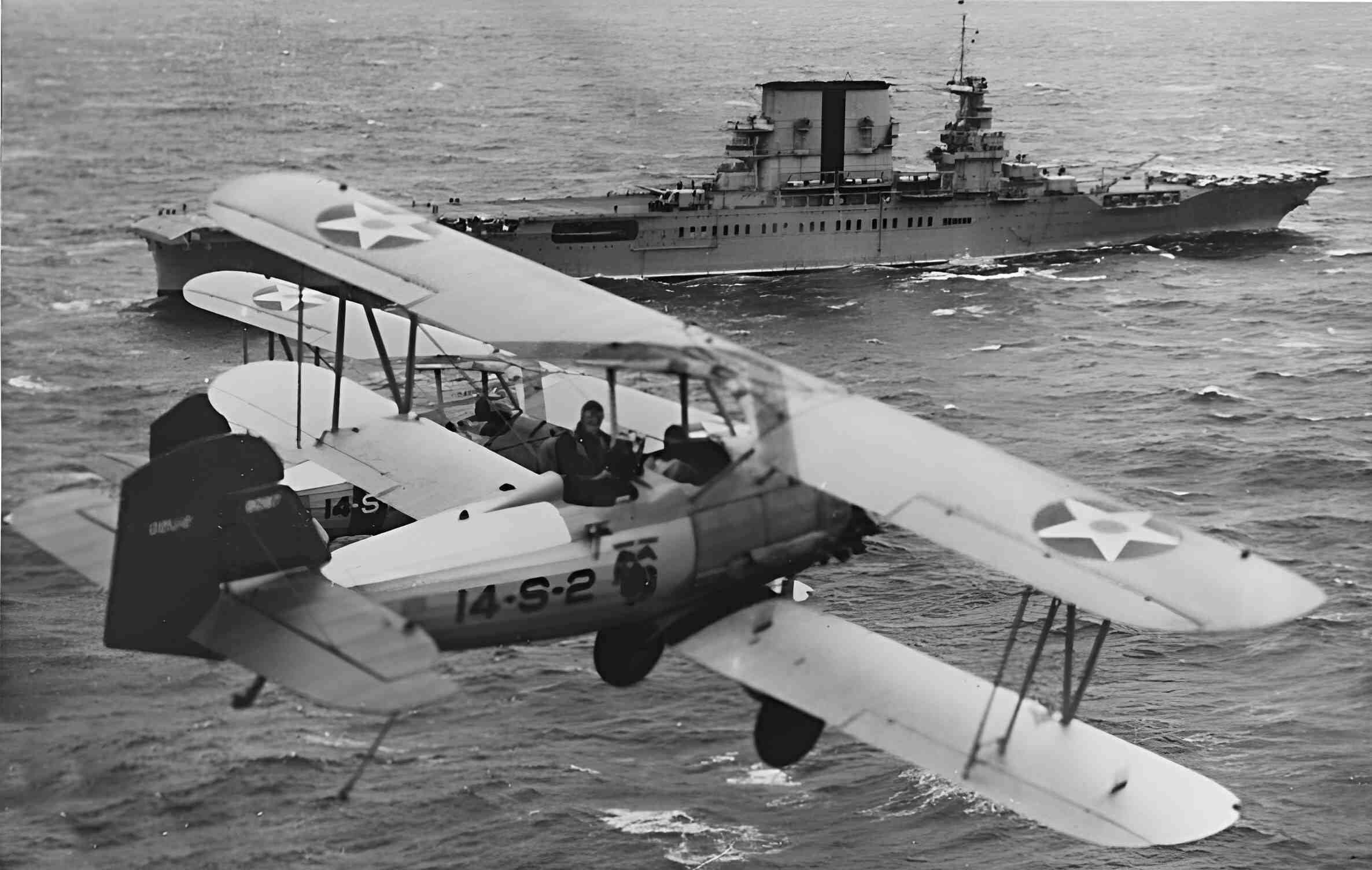Aircraft Carrier Life in the 1930s

Inspection time once again.
No guesses on the type of aircraft peeking into the photo at the lower right, but one can say with certainty that the vessel it rests upon is the USS Lexington. Sister ship Saratoga is in the background.
The War Can Wait…

Los Angeles, Mines Field, 1943. When the ice cream man arrived, work came to a halt outside North American Aviation’s plant.
The pair of Mustangs are an interesting duo: the first P-51 “B” model (43-12093), and an RAF bird (FX863, also a “B” model). 43-12093, befitting its first-in-the-series status, was retained by NAA for test purposes. (Notice it is experimenting with a three-bladed propellor). Our Mustang III, FX863, never made it to the RAF but was instead handed over to the USAAF and eventually saw combat in the skies over Europe with the 357th Fighter Group.
Bats Outta Hell
Grasshoppers
The B-52 A-Model
A grand total of three B-52A’s were built. Here, according to the accompanying citations, are all three of them.
The B-52D
One of Curtiss’s Countless Hawks

Over the years, Curtiss built the following:
Hawk, Hawk I, Hawk II, Turkeyhawk, Goshawk, Seahawk, Sparrowhawk, Goshawk (again), Hawk III, Hawk IV, Mohawk, Tomahawk, Kittyhawk, Warhawk, Seahawk (also again). Oh, and Curtiss also built a Hawk I for the Gulf Oil Company. It was named, you guessed it, the Gulfhawk.
The aircraft seen here is the P-3A (Hawk).
If “Hawk” could be tacked onto a word (or supplemented with Roman numerals) then Curtiss would immediately do so.
An Unfortunate Fortress

Some planes are unlucky; 42-5846 of the 535th Bomb Squadron, 381st Bomb Group at RAF Ridgewell was once such aircraft. In approximately six months of combat service, this B-17F, nicknamed “Tinker Toy“, had more than its fair share of sorrows. On one mission, the navigator was killed by flak. A later mission was even more harrowing when flak and fighters tore through the formation, resulting in the pilot killed and the copilot wounded. The flight engineer, after pulling the body of the pilot from his seat, flew the aircraft back to England, where he and the injured copilot made a successful landing.
On the 20th of December, 1943, Tinker Toy’s run of less than stellar fortune ran out: the plane was engaged by a BF-109 who, after raking the B-17 with gunfire, collided with its target, and both planes went down locked together. Seven men died in the Fortress, and the other three crewmen were taken prisoner.
Thus ended the saga of an unlucky B-17, but such tales were well-known to the bomber crews of the 8th Air Force during World War II.
The 707 Mini
It is easy to look at photos of a 707 and say to oneself, “Look, it is a 707”. However, any aficionado of Boeing’s first jet airliner knows there are more than a dozen 707 variants, and one of those derivatives was the 707-138B. Shorter by ten feet compared to the standard 707-120, the 138B was used exclusively by Qantas Empire Airways, which favored the abbreviated version due to its increased range.
The aircraft seen here, N-93134, is the first 138B built and was initially used for testing by Boeing. That project completed, in July of 1961, the bird was off to Australia as VH-EBH, “City of Darwin”.
One of the interesting details in these photos is that even though Boeing was using the plane for testing, it already bears most of the red and white livery of its ultimate customer: Qantas.
Randolph Field, 1930s
A small collection of photos from a flying cadet at Randolph Field in the mid-1930s.
It’s a Grumman Mallard
Already an exceptionally nice-looking plane, this Grumman G-73 was made even more handsome after Wien and their paint shop got through with it. Nicknamed the “Katmai Queen,” this Mallard (N1208) was caught on camera at Boeing Field sometime in the 1970s.
In photo #1, a DC-7 of the “Stardusters Air Travel Club” is visible.
Boeing 314 #1

These photographs feature the first Model 314 produced by Boeing (later registered as NX18601). As with most prototypes, the first 314 model encountered some challenges during its development. One of the primary issues was related to lateral control. Although the aircraft was built with a standard single centerline vertical fin, early test flights revealed a need for more lateral control. To address this problem, a growing number of vertical stabilizers were installed on the aircraft. Initially, the solo center tail was removed and replaced with a pair of endplates. However, this dual arrangement proved insufficient, and a centerline fin was once again added to the aircraft, which proved to be effective in providing the necessary lateral stability. once again the 314 was provided with a centerline fin (Hey, good thing they didn’t throw that item away when they did the initial redesign of the tail)
Here’s a Pair of Oddball Amphibs…
Goodyear’s Ducks
First flown in 1944, Goodyear’s GA Duck was a very handsome and well-performing aircraft, but (alas) it never went into major production. Of the less than two dozen built, one survives today.
Sea Ranger on the Step

On a sunny day in Seattle, Boeing’s one and only XPBB-1 “Sea Ranger” races over the waters of Lake Washington as it heads for the skies.
It is worth noting that the orderly ripples on the otherwise smooth lake surface are likely manmade.
Story follows:
Per my late Dad (a WWII PBY pilot), ultra-smooth water can make for a problematic takeoff. Reason: the aircraft could have trouble breaking free from the water’s adhesive properties. Therefore, said Dad, a boat would be dispatched to speed about and ripple up the water on a smooth, non-windy day. Lacking a boat, the aircraft could engage in some downwind high-speed taxiing, then do a quick 180-degree turn and takeoff courtesy of the undulating ripplets now creasing the water.
The B-50 SuperDuperFortress
Here are a few PVs of VPB-146…
Pair of P-51s
The first photo shows Bob standing on a wing. Bob (Chilton) has a great job: he is North American’s test pilot and, therefore, gets to fly brand-new Mustangs for his daily bread. The second photo shows one of the birds that may have been given the O-K back at the factory by Mr. Chilton himself (a P-51B, 42-106829 of the 362nd Fighter Squadron).
79th Air Rescue Squadron

An SH-19A Chickasaw displays its abilities before an appreciative B-36 of the 6th Bomb Wing while the latter is on a deployment to Andersen AFB, Guam. The bomber was far from its home at Walker AFB in New Mexico – about 7,000 miles – but that really wasn’t a very big deal for a B-36.
The Last Thing Seen by Many a Bug or Caterpillar

And…For the sake of the photographer’s health, one hopes he got all he needed with a single pass by the chemical-spewing Stearman. The good news for him is that by the time this picture was taken in the 1950s, the crop dusters were no longer using what had proven highly effective in the past: a liquid mixture of lead and arsenic. Seems like a bad idea now, but it didn’t at the time. We humans are like that – we only learn by experience (when does the city put up a stop sign at an unmarked intersection, before a bad car wreck, or after?).
The location is Washington state, the target, apple trees, and the critters and caterpillars that love them.
Corsairs & Seagulls
Here are two aircraft that had ridiculously long service lives by the standards of their time: Vought’s many variations of the O2U Corsair and the Curtiss SOC Seagull. In an era when an aircraft was here and gone in only a few years, the Corsair and Seagull served the US Navy for 19 and 14 years, respectively (and approximately).
O2U-2, VS-14M, CV-3, 1930
























































































































